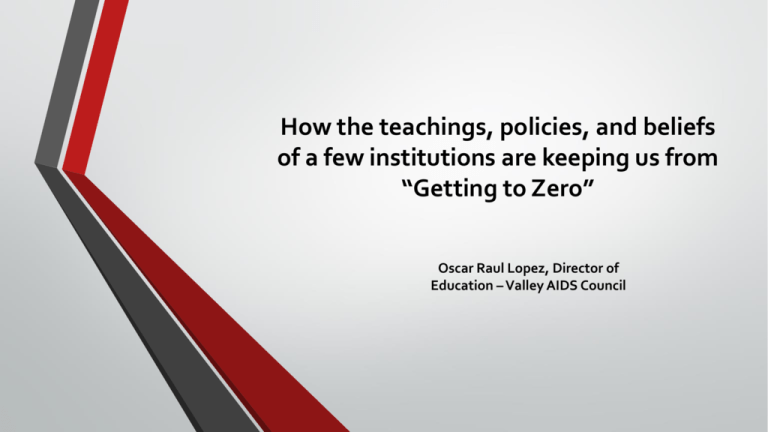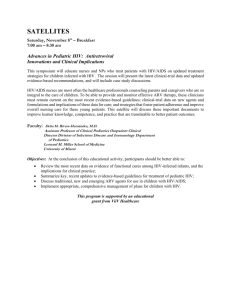
How the teachings, policies, and beliefs
of a few institutions are keeping us from
“Getting to Zero”
Oscar Raul Lopez, Director of
Education – Valley AIDS Council
• Topics Discussed Include:
• Abstinence Only Sex Ed
• Sex or Slut Shaming
• HIV Criminalization
• The War on Drugs/Criminal Justice
• Immigration
•
•
•
•
•
•
•
•
•
•
https://www.youtube.com/watch?v=-7Sixv7uQOM
https://www.youtube.com/watch?v=S7XzA8VzkXg
https://www.youtube.com/watch?v=ne4fAqDqpX8
http://www.msnbc.com/msnbc/watch/trump-criticizes-mexican-immigrants466388035962
http://www.bing.com/videos/search?q=racist+ihop+video&FORM=VIRE7#view=detail
&mid=ECEDD02BE2AB70506F7FECEDD02BE2AB70506F7F
https://www.youtube.com/watch?v=q7Iyrf3pkjE
http://link.brightcove.com/services/player/bcpid932647471001?bckey=AQ~~,AAAAGu
N0bcE~,rS1wzGXkRNkBi1RYglqd0AIIsZiMZoqu&bctid=4142603018001
http://www.wtvm.com/story/27634932/woman-charged-with-exposing-partner-to-hiv
http://www.cbsnews.com/videos/immigrant-children-crossing-border-into-unitedstates-to-escape-violence/
https://www.youtube.com/watch?v=BmGBvulpleM
Why this matters…
• African Americans, who make up only 14 percent of the U.S.
population, make up 44 percent of the HIV-positive population.
• Latinos face three times the HIV infection rates as whites.
• Men who have sex with men represent 2 percent of the U.S.
population but account for 61 percent of all new HIV infections.
• Race—as it intersects with poverty, gender, and sexuality among other
factors—becomes the embodiment of a multifaceted social exclusion
and the rationalization for massive health inequities.
Abstinence Only Sex Education
• Accurate, balanced comprehensive sex education – including information
about contraception and condoms – is a basic human right of youth. Such
education helps young people to reduce their risk of potentially negative
outcomes, such as unwanted pregnancies and sexually transmitted
infections.
•
Such education can also help youth to enhance the quality of their
relationships and to develop decision-making skills that will prove
invaluable over life. This basic human right is also a core public health
principle that receives strong endorsement from mainstream medical
associations, public health and educational organizations, and – most
important – parents.
The Claim: Research shows that abstinence-only education delays sexual
initiation and reduces teen pregnancy.
The Facts: Abstinence-only education programs are not effective at delaying
the initiation of sexual activity or in reducing teen pregnancy.
A long-awaited, federally-funded evaluation of four carefully selected
abstinence-only education programs, published in April 2007, showed that
youth enrolled in the programs were no more likely than those not in the
programs to delay sexual initiation, to have fewer sexual partners, or to
abstain entirely from sex.
A 2004 evaluation from Texas found no significant changes in the percentage
of students who pledged not to have sex until marriage. As in two other
studies, the Texas analysis revealed that the percentage of students who
reported having engaged in sexual intercourse increased for nearly all ages.[
The Claim: Abstinence-only-until-marriage programs reflect American values.
The Facts: Objective data confirm that abstinence-until-marriage does not
reflect American values. The median age of sexual initiation among Americans
is 17 and the average age of marriage is 25.8 for women and 27.4 for men. This
age difference clearly indicates a long time between sexual onset and
marriage. In a major, nationally representative survey, 95 percent of adult
respondents, ages 18 through 44, reported that they had sex before marriage.
Even among those who abstained from sex until age 20 or older, 81 percent
reported having had premarital sex.
The Claim: Parents want abstinence-only education to be taught in schools.
The Facts: Most Americans want far more than abstinence-only in schools.
Only fifteen percent of American adults believe that schools should teach
abstinence from sexual intercourse and should not provide information on
how to obtain and use condoms and other contraception.
Most Americans want a broad sex education curriculum that teaches the
basics—from how babies are made to how to put on a condom and how to get
tested for STIs.
•
•
•
•
•
•
•
99 percent want youth to get information on other STIs in addition to HIV.
98 percent want youth to be taught about HIV/AIDS.
96 percent want youth to learn the “basics of how babies are made.”
94 percent want youth to learn how to get tested for HIV and other STIs.
93 percent want youth to be taught about “waiting to have sexual intercourse until
married.”
83 percent want youth to know how to put on a condom.
71 percent believe that teens need to know that they can “obtain birth control pills from
family planning clinics without permission from a parent.”
Abstinence Only Sex Education
•
•
•
Abstinence-Only Programs Do Not Impact Teen Sexual Behavior.
Policies that promote abstinence as the only choice or that withhold important health
information place individuals at risk for making unhealthy decisions. Whether or not
one prefers abstinence as the solution for unmarried teenagers, the reality is that
many young people are sexually active and at risk for HIV/AIDS and other sexually
transmitted diseases. In addition, many sex education policies provide a
predominantly heterosexual perspective, excluding the health needs of lesbian, gay,
bisexual, and transgender adolescents, while indirectly stigmatizing them.
Only one in four of 15– to 17-year-old sexually experienced youth say they have ever
been tested for HIV. In a recent survey, only 46% of 15- to 17-year-olds say they knew
where to get tested for HIV infection or other STDs.
Sex or Slut Shaming
• You don’t have to dig deep into any discussion of PrEP before you come
across people who will dismiss it on the basis that it ‘just encourages
irresponsible behavior’.
•
Lurking in the back of many of our minds remains the notion that the sex
we have is wrong.
• Stigmatization of people living with HIV: they deserved it because they had
the wrong type of sex, or sex with the wrong number of people.
• Because the mainstream gay community has become a self-policing bastion
of heteronormativity. We have shamed each other into sexual silence. We
don’t talk about sex — and we certainly don’t celebrate it, unless it’s the kind
that is on its way to becoming part of an acceptable marriage.
• Our sexual shame is a public health problem of epidemiological proportions
and our sexual shame erases the history of years of queer community
organizing and consciousness-raising around good sex. It blinds us from our
own desires as homo-sexual beings. It prevents us from showing our faces
on Grindr and Scruff, forcing us instead to beg for face pics after we’ve
supposedly already come out of the closet. It makes us susceptible to
addition (sex, drugs) as we struggle to escape from our inhibitions. It bars us
from campaigning for treatment as prevention and PrEP or for educating
about the implications of an undetectable viral load.
• The concern with condomless sex is not unwarranted — and sex with
condoms is not always safe. But concerns with risk and safety cannot be
effectively addressed so long as our communities suffer from sexual shame.
“What if you’re wrong about PrEP?”
“a public health disaster in the making.”
“party drug”
“associated with bareback porn.”
Michael Weinstein, Founder and Executive Director of
the AIDS Health Care Foundation
“the bottom line is that people
won’t adhere and take the pill.”
Baseline condom use among gay men is already often poor, PrEP or no PrEP.
While Mr. Weinstein worries about damage to the 34 year old condom culture,
the failure of condom culture to stop the epidemic among gay and bisexual
men is one of the main reasons HIV professionals are excited about PrEP.
HIV Criminalization
• Criminalization under HIV exposure laws is a significant structural factor
that deters individuals from accessing HIV testing and perpetuates stigma.
As of 2014, 38 states and U.S. territories have laws that specifically
criminalize HIV exposure through consensual sex, needle-sharing, or
through spitting and biting. Some states do not have HIV-specific laws, but
instead utilize general criminal laws like attempted murder or assault, to
prosecute HIV-positive people for HIV exposure.
HIV Criminalization
• Importantly, exposure laws contradict public health messages by putting
the full responsibility for HIV prevention solely on the person living with HIV,
rather than encouraging all people to ask their sexual partners about their
HIV status and to use condoms. This system effectively penalizes HIVpositive people for knowing their HIV status and results in one person’s word
placed against another’s as to whether the positive person disclosed his or
her status, with the HIV-positive person usually losing. Because people who
do not know their HIV status are much more likely to transmit HIV than
those who know they are positive, these misguided laws fail to address
the root problem.
HIV Criminalization
• Moreover, HIV transmission laws dangerously feed into this nexus of
disparities for blacks and Latinos, conflating the much-needed HIV
prevention and care sector with the criminal justice system and often using
public health officials as tools of criminalization.
The War on Drugs/Criminal Justice
• Incarcerated populations and those under criminal justice supervision (such
as parole and probation) represent a large and growing segment of the U.S.
population. These groups experience elevated rates of HIV, STIs, and other
diseases. Nearly 11 million Americans (who are disproportionately black and
Latino) are incarcerated at some point of each year, and an estimated 17
percent of those individuals are living with HIV/ AIDS—a rate substantially
higher than that of the general population.
• In-custody transmission of HIV, which can occur through sexual activity,
including sexual assault, needle-sharing for drug injection, and tattooing
with unsterilized equipment is an important concern. Despite the high risk,
less than 1 percent of jails and prisons in the United States make condoms
accessible to incarcerated individuals.
The War on Drugs/Criminal Justice
•
•
Attention must also be focused on the ongoing impact of incarceration on
relationship stability and male-female sex ratios in black and Latino communities.
The removal of potential and actual sexual partners from society through
incarceration has dramatic impacts on the partners and families left behind.
Specifically, this removal can condense sexual networks and as a result, increase
HIV risk.
Further, criminal prosecution has additional dire consequences for individuals, their
loved ones, and their communities due to the collateral consequences of conviction
such as the termination of government benefits (including housing, food
assistance, and financial aid for higher education) that are essential to keeping HIVpositive people in care, difficulty seeking employment due to requirements to
disclose prior convictions and the loss of parental rights.
Immigration
• Immigrants face complex structural obstacles, which may contribute to their
increased vulnerability to illness and a limited range of choices related to
their health and well-being.
• Several studies demonstrate that foreign-born individuals living in the
United States are more likely than those born here to enter into HIV care
late, to have low T-cell counts and as a result have a weakened immune
system at the time of diagnosis, and to be diagnosed with HIV concurrently
with AIDS.
• 10% of HIV positive Latinos die within 12 months of receiving an HIV
diagnosis because they waited too long to get tested.
Immigration
• Undocumented immigrants fear “the system,” including the risk that seeking
medical help could lead to deportation or other adverse legal consequences.
• The mental health effects of immigrant stigma might increase the
vulnerability of sexual minority immigrants toward patterns of behavior that
put them at increased risk for HIV, such as injection drug use, alcohol
consumption, and unprotected anal sex.
• LGBT immigrants face multiple challenges, which are often rendered invisible
by the predominant view of immigrants as heterosexual. Sexual minorities
access geographical mobility through the resources available through
biological families and nonkin relations. This suggests that immigration itself
may help immigrants negotiate disclosure, discrimination, and privacy
concerns by creating distance between immigrants and their biological
families. This separation, however, means that any ongoing support they may
need from family will be harder to access.
What can we do?
•
•
•
•
•
•
Redistribute HIV/AIDS funding to reflect the disproportionate burden in the South
Increase funding of research designed to determine the role that sexual networks play
in racial disparities in HIV transmission
Provide comprehensive and free health and sexual health education
Support the REPEAL HIV Discrimination Act
Develop programs that facilitate voluntary HIV status disclosure
Increased cultural competency among HIV/AIDS providers, public health officials, and
advocates
1.5 Million Missing Black Men
By JUSTIN WOLFERS, DAVID LEONHARDT and KEVIN QUEALY APRIL 20, 2015
http://www.nytimes.com/interactive/2015/04/20/upshot/missing-blackmen.html?abt=0002&abg=1&_r=0




